Leadership Styles and Motivation in Workplace
VerifiedAdded on 2020/02/05
|17
|5117
|383
Report
AI Summary
This assignment delves into the multifaceted relationship between leadership styles and their impact on various aspects of the workplace. It examines how different leadership styles predict self-reported and observed workplace bullying, highlighting the importance of fostering ethical and supportive environments. Furthermore, it investigates the antecedents and consequences of ethical leadership, emphasizing its role in shaping employee motivation and organizational performance. The assignment also explores shared leadership models and teamwork effectiveness within agile projects.
Contribute Materials
Your contribution can guide someone’s learning journey. Share your
documents today.
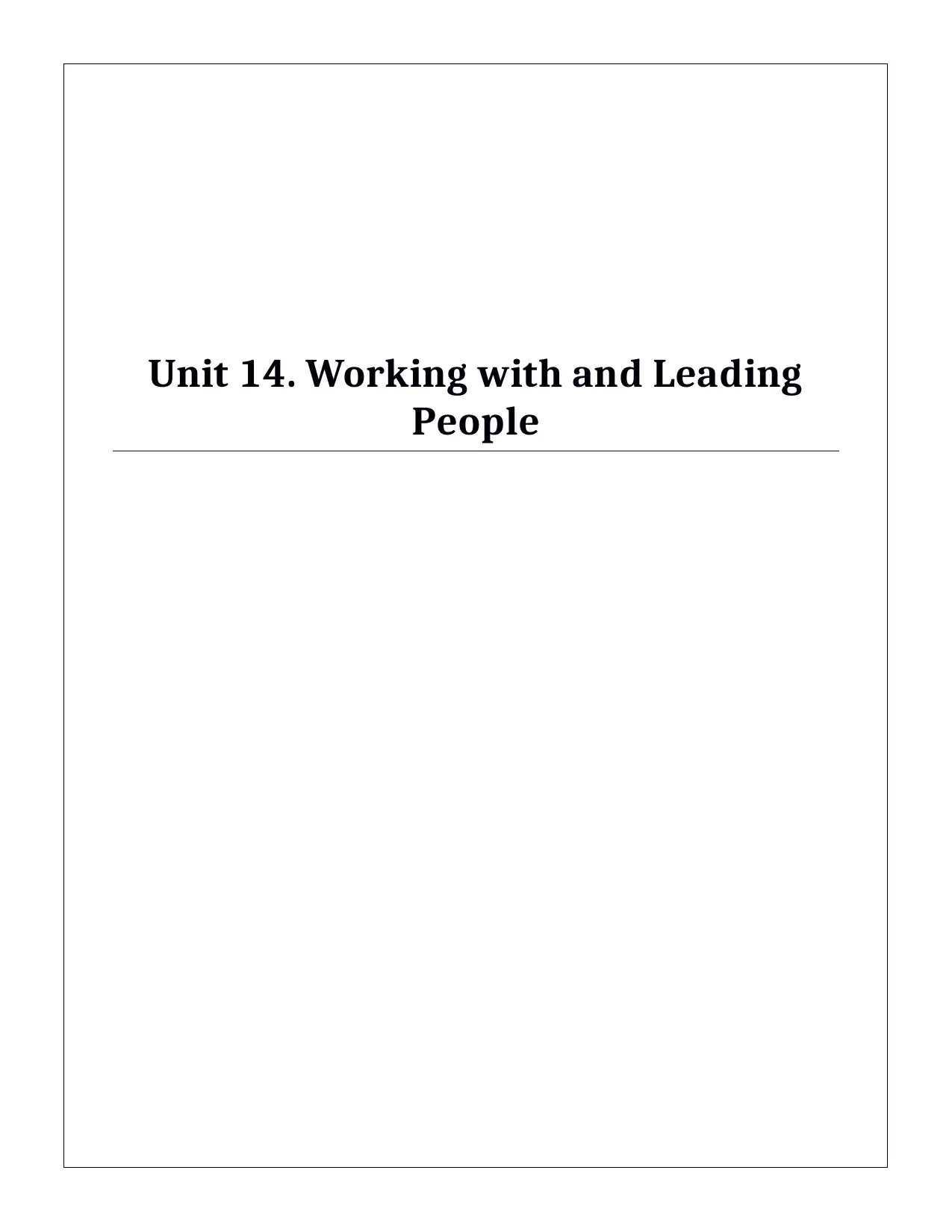
Unit 14. Working with and Leading
People
People
Secure Best Marks with AI Grader
Need help grading? Try our AI Grader for instant feedback on your assignments.
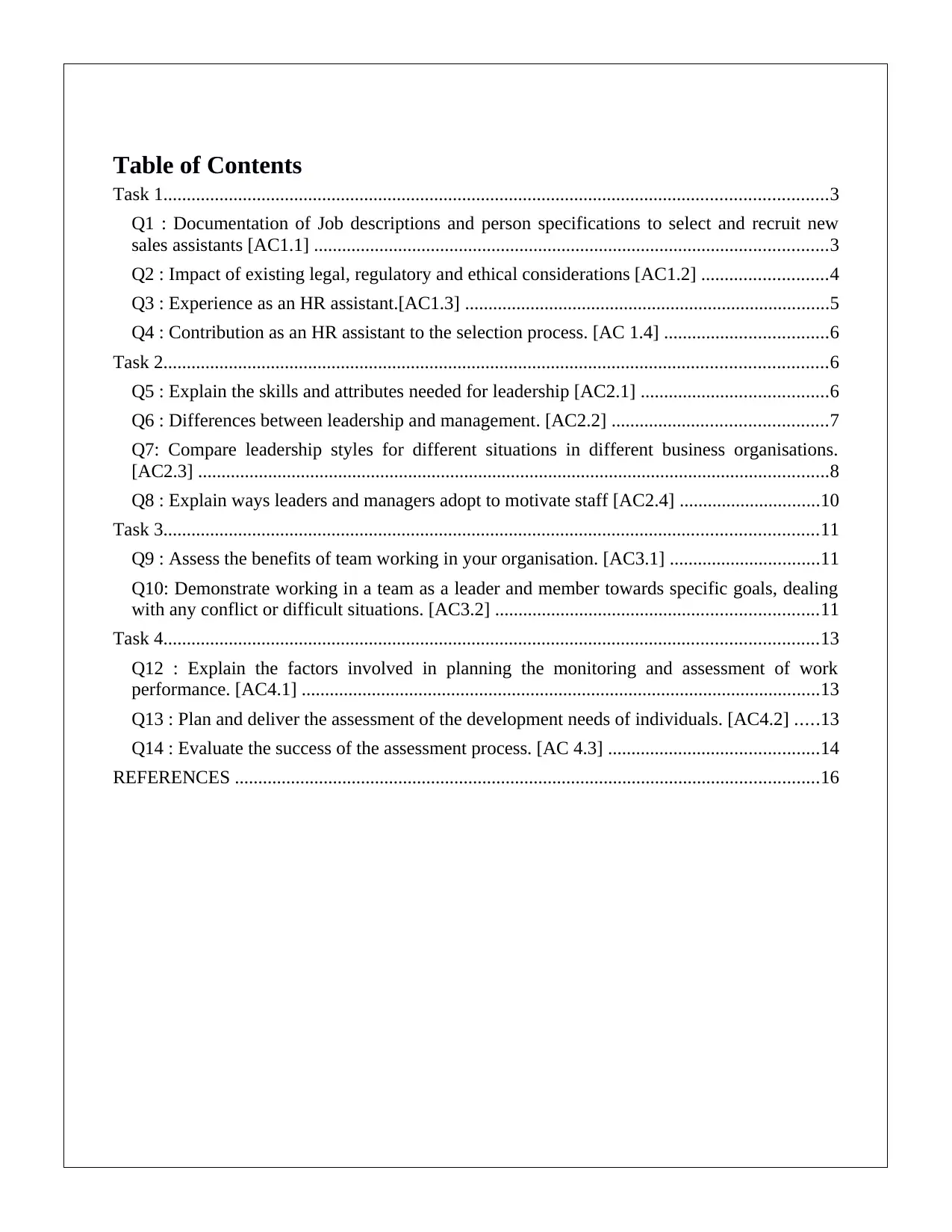
Table of Contents
Task 1..............................................................................................................................................3
Q1 : Documentation of Job descriptions and person specifications to select and recruit new
sales assistants [AC1.1] ..............................................................................................................3
Q2 : Impact of existing legal, regulatory and ethical considerations [AC1.2] ...........................4
Q3 : Experience as an HR assistant.[AC1.3] ..............................................................................5
Q4 : Contribution as an HR assistant to the selection process. [AC 1.4] ...................................6
Task 2..............................................................................................................................................6
Q5 : Explain the skills and attributes needed for leadership [AC2.1] ........................................6
Q6 : Differences between leadership and management. [AC2.2] ..............................................7
Q7: Compare leadership styles for different situations in different business organisations.
[AC2.3] .......................................................................................................................................8
Q8 : Explain ways leaders and managers adopt to motivate staff [AC2.4] ..............................10
Task 3............................................................................................................................................11
Q9 : Assess the benefits of team working in your organisation. [AC3.1] ................................11
Q10: Demonstrate working in a team as a leader and member towards specific goals, dealing
with any conflict or difficult situations. [AC3.2] .....................................................................11
Task 4............................................................................................................................................13
Q12 : Explain the factors involved in planning the monitoring and assessment of work
performance. [AC4.1] ...............................................................................................................13
Q13 : Plan and deliver the assessment of the development needs of individuals. [AC4.2] .....13
Q14 : Evaluate the success of the assessment process. [AC 4.3] .............................................14
REFERENCES .............................................................................................................................16
Task 1..............................................................................................................................................3
Q1 : Documentation of Job descriptions and person specifications to select and recruit new
sales assistants [AC1.1] ..............................................................................................................3
Q2 : Impact of existing legal, regulatory and ethical considerations [AC1.2] ...........................4
Q3 : Experience as an HR assistant.[AC1.3] ..............................................................................5
Q4 : Contribution as an HR assistant to the selection process. [AC 1.4] ...................................6
Task 2..............................................................................................................................................6
Q5 : Explain the skills and attributes needed for leadership [AC2.1] ........................................6
Q6 : Differences between leadership and management. [AC2.2] ..............................................7
Q7: Compare leadership styles for different situations in different business organisations.
[AC2.3] .......................................................................................................................................8
Q8 : Explain ways leaders and managers adopt to motivate staff [AC2.4] ..............................10
Task 3............................................................................................................................................11
Q9 : Assess the benefits of team working in your organisation. [AC3.1] ................................11
Q10: Demonstrate working in a team as a leader and member towards specific goals, dealing
with any conflict or difficult situations. [AC3.2] .....................................................................11
Task 4............................................................................................................................................13
Q12 : Explain the factors involved in planning the monitoring and assessment of work
performance. [AC4.1] ...............................................................................................................13
Q13 : Plan and deliver the assessment of the development needs of individuals. [AC4.2] .....13
Q14 : Evaluate the success of the assessment process. [AC 4.3] .............................................14
REFERENCES .............................................................................................................................16
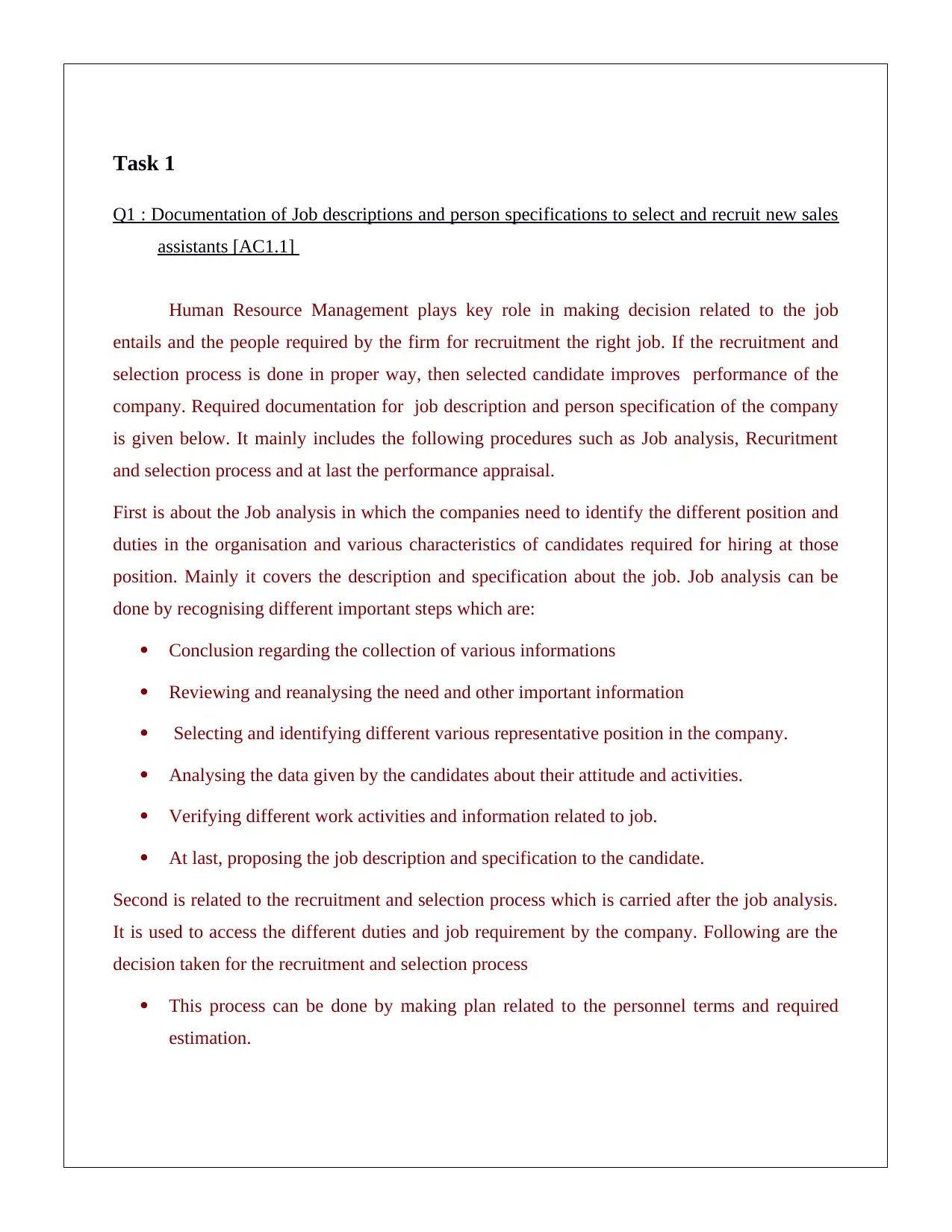
Task 1
Q1 : Documentation of Job descriptions and person specifications to select and recruit new sales
assistants [AC1.1]
Human Resource Management plays key role in making decision related to the job
entails and the people required by the firm for recruitment the right job. If the recruitment and
selection process is done in proper way, then selected candidate improves performance of the
company. Required documentation for job description and person specification of the company
is given below. It mainly includes the following procedures such as Job analysis, Recuritment
and selection process and at last the performance appraisal.
First is about the Job analysis in which the companies need to identify the different position and
duties in the organisation and various characteristics of candidates required for hiring at those
position. Mainly it covers the description and specification about the job. Job analysis can be
done by recognising different important steps which are:
Conclusion regarding the collection of various informations
Reviewing and reanalysing the need and other important information
Selecting and identifying different various representative position in the company.
Analysing the data given by the candidates about their attitude and activities.
Verifying different work activities and information related to job.
At last, proposing the job description and specification to the candidate.
Second is related to the recruitment and selection process which is carried after the job analysis.
It is used to access the different duties and job requirement by the company. Following are the
decision taken for the recruitment and selection process
This process can be done by making plan related to the personnel terms and required
estimation.
Q1 : Documentation of Job descriptions and person specifications to select and recruit new sales
assistants [AC1.1]
Human Resource Management plays key role in making decision related to the job
entails and the people required by the firm for recruitment the right job. If the recruitment and
selection process is done in proper way, then selected candidate improves performance of the
company. Required documentation for job description and person specification of the company
is given below. It mainly includes the following procedures such as Job analysis, Recuritment
and selection process and at last the performance appraisal.
First is about the Job analysis in which the companies need to identify the different position and
duties in the organisation and various characteristics of candidates required for hiring at those
position. Mainly it covers the description and specification about the job. Job analysis can be
done by recognising different important steps which are:
Conclusion regarding the collection of various informations
Reviewing and reanalysing the need and other important information
Selecting and identifying different various representative position in the company.
Analysing the data given by the candidates about their attitude and activities.
Verifying different work activities and information related to job.
At last, proposing the job description and specification to the candidate.
Second is related to the recruitment and selection process which is carried after the job analysis.
It is used to access the different duties and job requirement by the company. Following are the
decision taken for the recruitment and selection process
This process can be done by making plan related to the personnel terms and required
estimation.
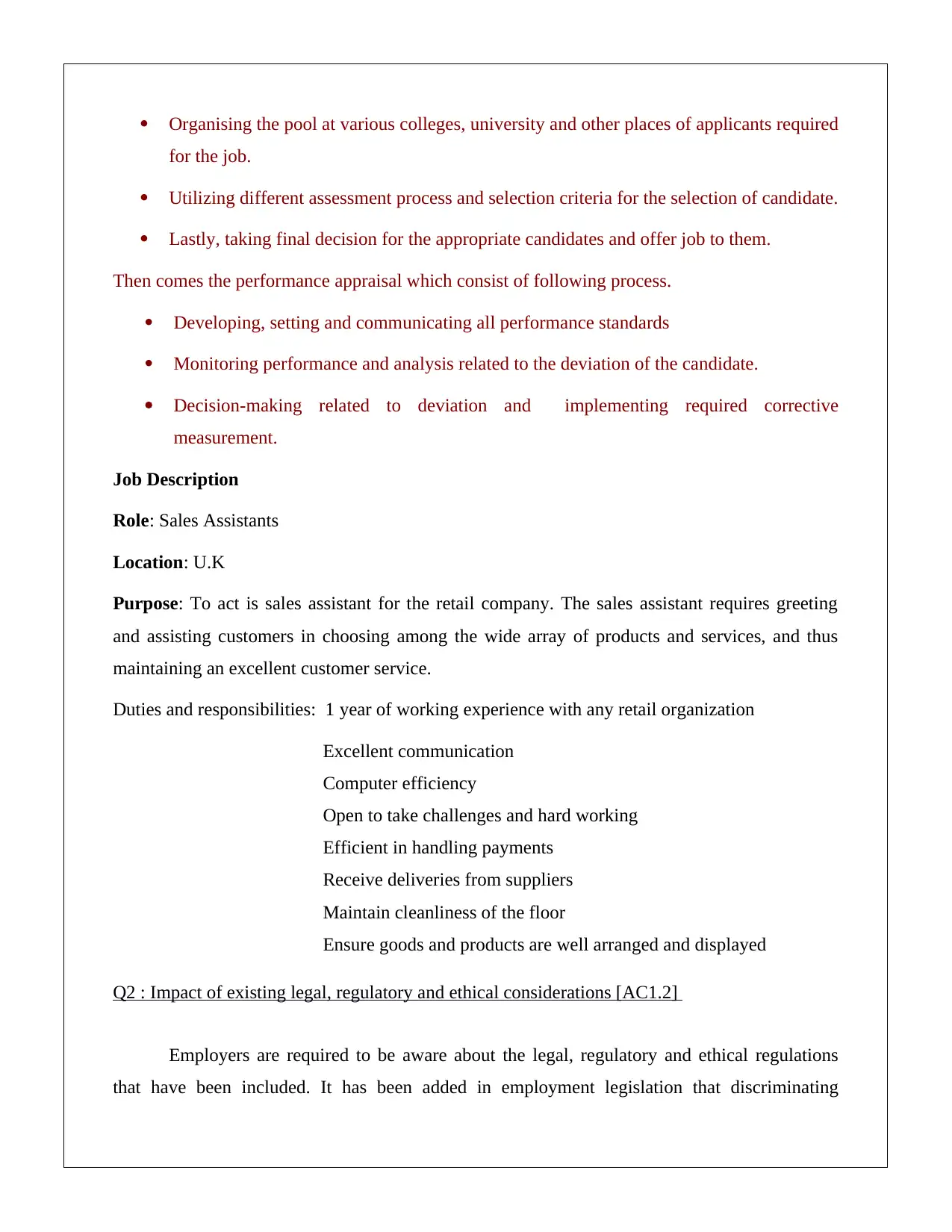
Organising the pool at various colleges, university and other places of applicants required
for the job.
Utilizing different assessment process and selection criteria for the selection of candidate.
Lastly, taking final decision for the appropriate candidates and offer job to them.
Then comes the performance appraisal which consist of following process.
Developing, setting and communicating all performance standards
Monitoring performance and analysis related to the deviation of the candidate.
Decision-making related to deviation and implementing required corrective
measurement.
Job Description
Role: Sales Assistants
Location: U.K
Purpose: To act is sales assistant for the retail company. The sales assistant requires greeting
and assisting customers in choosing among the wide array of products and services, and thus
maintaining an excellent customer service.
Duties and responsibilities: 1 year of working experience with any retail organization
Excellent communication
Computer efficiency
Open to take challenges and hard working
Efficient in handling payments
Receive deliveries from suppliers
Maintain cleanliness of the floor
Ensure goods and products are well arranged and displayed
Q2 : Impact of existing legal, regulatory and ethical considerations [AC1.2]
Employers are required to be aware about the legal, regulatory and ethical regulations
that have been included. It has been added in employment legislation that discriminating
for the job.
Utilizing different assessment process and selection criteria for the selection of candidate.
Lastly, taking final decision for the appropriate candidates and offer job to them.
Then comes the performance appraisal which consist of following process.
Developing, setting and communicating all performance standards
Monitoring performance and analysis related to the deviation of the candidate.
Decision-making related to deviation and implementing required corrective
measurement.
Job Description
Role: Sales Assistants
Location: U.K
Purpose: To act is sales assistant for the retail company. The sales assistant requires greeting
and assisting customers in choosing among the wide array of products and services, and thus
maintaining an excellent customer service.
Duties and responsibilities: 1 year of working experience with any retail organization
Excellent communication
Computer efficiency
Open to take challenges and hard working
Efficient in handling payments
Receive deliveries from suppliers
Maintain cleanliness of the floor
Ensure goods and products are well arranged and displayed
Q2 : Impact of existing legal, regulatory and ethical considerations [AC1.2]
Employers are required to be aware about the legal, regulatory and ethical regulations
that have been included. It has been added in employment legislation that discriminating
Secure Best Marks with AI Grader
Need help grading? Try our AI Grader for instant feedback on your assignments.
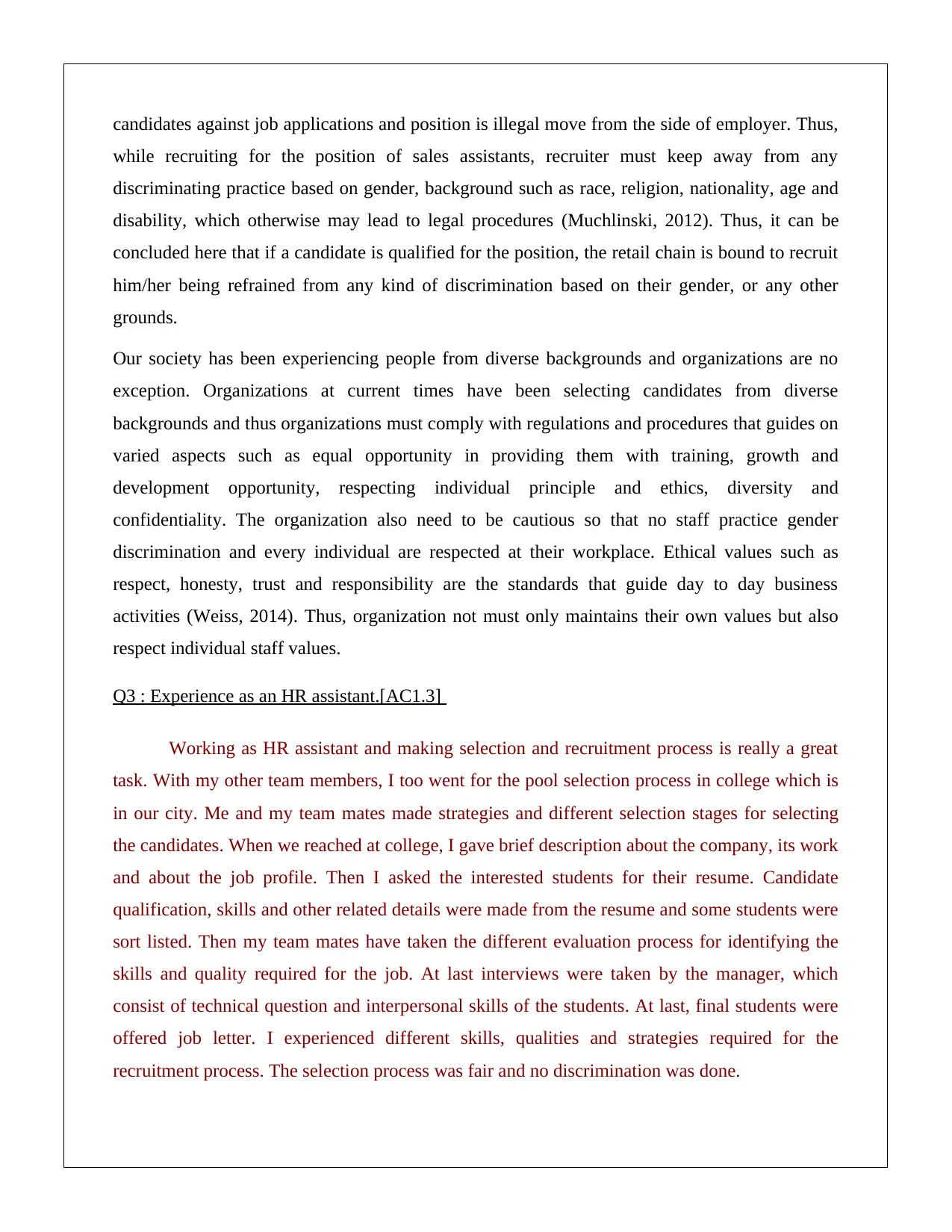
candidates against job applications and position is illegal move from the side of employer. Thus,
while recruiting for the position of sales assistants, recruiter must keep away from any
discriminating practice based on gender, background such as race, religion, nationality, age and
disability, which otherwise may lead to legal procedures (Muchlinski, 2012). Thus, it can be
concluded here that if a candidate is qualified for the position, the retail chain is bound to recruit
him/her being refrained from any kind of discrimination based on their gender, or any other
grounds.
Our society has been experiencing people from diverse backgrounds and organizations are no
exception. Organizations at current times have been selecting candidates from diverse
backgrounds and thus organizations must comply with regulations and procedures that guides on
varied aspects such as equal opportunity in providing them with training, growth and
development opportunity, respecting individual principle and ethics, diversity and
confidentiality. The organization also need to be cautious so that no staff practice gender
discrimination and every individual are respected at their workplace. Ethical values such as
respect, honesty, trust and responsibility are the standards that guide day to day business
activities (Weiss, 2014). Thus, organization not must only maintains their own values but also
respect individual staff values.
Q3 : Experience as an HR assistant.[AC1.3]
Working as HR assistant and making selection and recruitment process is really a great
task. With my other team members, I too went for the pool selection process in college which is
in our city. Me and my team mates made strategies and different selection stages for selecting
the candidates. When we reached at college, I gave brief description about the company, its work
and about the job profile. Then I asked the interested students for their resume. Candidate
qualification, skills and other related details were made from the resume and some students were
sort listed. Then my team mates have taken the different evaluation process for identifying the
skills and quality required for the job. At last interviews were taken by the manager, which
consist of technical question and interpersonal skills of the students. At last, final students were
offered job letter. I experienced different skills, qualities and strategies required for the
recruitment process. The selection process was fair and no discrimination was done.
while recruiting for the position of sales assistants, recruiter must keep away from any
discriminating practice based on gender, background such as race, religion, nationality, age and
disability, which otherwise may lead to legal procedures (Muchlinski, 2012). Thus, it can be
concluded here that if a candidate is qualified for the position, the retail chain is bound to recruit
him/her being refrained from any kind of discrimination based on their gender, or any other
grounds.
Our society has been experiencing people from diverse backgrounds and organizations are no
exception. Organizations at current times have been selecting candidates from diverse
backgrounds and thus organizations must comply with regulations and procedures that guides on
varied aspects such as equal opportunity in providing them with training, growth and
development opportunity, respecting individual principle and ethics, diversity and
confidentiality. The organization also need to be cautious so that no staff practice gender
discrimination and every individual are respected at their workplace. Ethical values such as
respect, honesty, trust and responsibility are the standards that guide day to day business
activities (Weiss, 2014). Thus, organization not must only maintains their own values but also
respect individual staff values.
Q3 : Experience as an HR assistant.[AC1.3]
Working as HR assistant and making selection and recruitment process is really a great
task. With my other team members, I too went for the pool selection process in college which is
in our city. Me and my team mates made strategies and different selection stages for selecting
the candidates. When we reached at college, I gave brief description about the company, its work
and about the job profile. Then I asked the interested students for their resume. Candidate
qualification, skills and other related details were made from the resume and some students were
sort listed. Then my team mates have taken the different evaluation process for identifying the
skills and quality required for the job. At last interviews were taken by the manager, which
consist of technical question and interpersonal skills of the students. At last, final students were
offered job letter. I experienced different skills, qualities and strategies required for the
recruitment process. The selection process was fair and no discrimination was done.
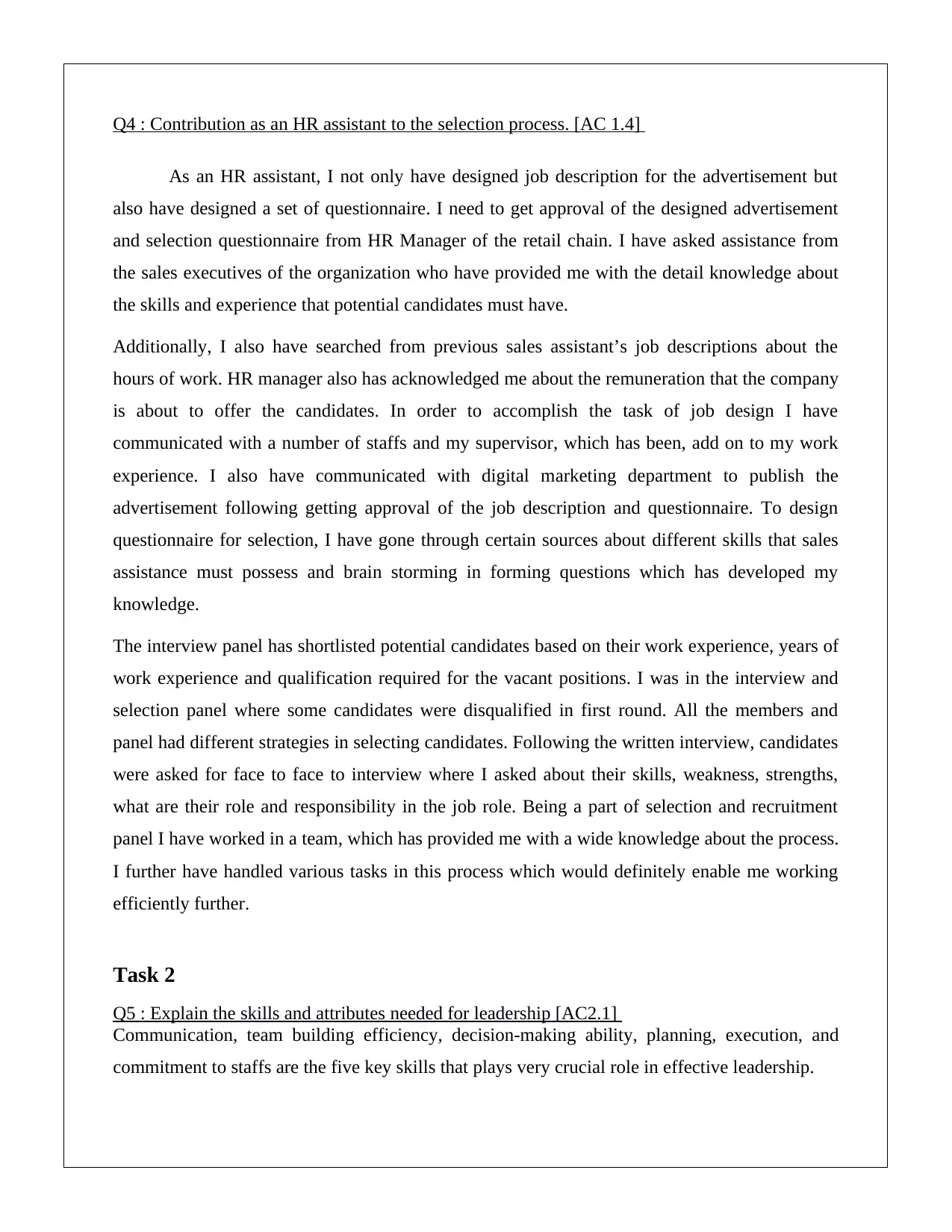
Q4 : Contribution as an HR assistant to the selection process. [AC 1.4]
As an HR assistant, I not only have designed job description for the advertisement but
also have designed a set of questionnaire. I need to get approval of the designed advertisement
and selection questionnaire from HR Manager of the retail chain. I have asked assistance from
the sales executives of the organization who have provided me with the detail knowledge about
the skills and experience that potential candidates must have.
Additionally, I also have searched from previous sales assistant’s job descriptions about the
hours of work. HR manager also has acknowledged me about the remuneration that the company
is about to offer the candidates. In order to accomplish the task of job design I have
communicated with a number of staffs and my supervisor, which has been, add on to my work
experience. I also have communicated with digital marketing department to publish the
advertisement following getting approval of the job description and questionnaire. To design
questionnaire for selection, I have gone through certain sources about different skills that sales
assistance must possess and brain storming in forming questions which has developed my
knowledge.
The interview panel has shortlisted potential candidates based on their work experience, years of
work experience and qualification required for the vacant positions. I was in the interview and
selection panel where some candidates were disqualified in first round. All the members and
panel had different strategies in selecting candidates. Following the written interview, candidates
were asked for face to face to interview where I asked about their skills, weakness, strengths,
what are their role and responsibility in the job role. Being a part of selection and recruitment
panel I have worked in a team, which has provided me with a wide knowledge about the process.
I further have handled various tasks in this process which would definitely enable me working
efficiently further.
Task 2
Q5 : Explain the skills and attributes needed for leadership [AC2.1]
Communication, team building efficiency, decision-making ability, planning, execution, and
commitment to staffs are the five key skills that plays very crucial role in effective leadership.
As an HR assistant, I not only have designed job description for the advertisement but
also have designed a set of questionnaire. I need to get approval of the designed advertisement
and selection questionnaire from HR Manager of the retail chain. I have asked assistance from
the sales executives of the organization who have provided me with the detail knowledge about
the skills and experience that potential candidates must have.
Additionally, I also have searched from previous sales assistant’s job descriptions about the
hours of work. HR manager also has acknowledged me about the remuneration that the company
is about to offer the candidates. In order to accomplish the task of job design I have
communicated with a number of staffs and my supervisor, which has been, add on to my work
experience. I also have communicated with digital marketing department to publish the
advertisement following getting approval of the job description and questionnaire. To design
questionnaire for selection, I have gone through certain sources about different skills that sales
assistance must possess and brain storming in forming questions which has developed my
knowledge.
The interview panel has shortlisted potential candidates based on their work experience, years of
work experience and qualification required for the vacant positions. I was in the interview and
selection panel where some candidates were disqualified in first round. All the members and
panel had different strategies in selecting candidates. Following the written interview, candidates
were asked for face to face to interview where I asked about their skills, weakness, strengths,
what are their role and responsibility in the job role. Being a part of selection and recruitment
panel I have worked in a team, which has provided me with a wide knowledge about the process.
I further have handled various tasks in this process which would definitely enable me working
efficiently further.
Task 2
Q5 : Explain the skills and attributes needed for leadership [AC2.1]
Communication, team building efficiency, decision-making ability, planning, execution, and
commitment to staffs are the five key skills that plays very crucial role in effective leadership.
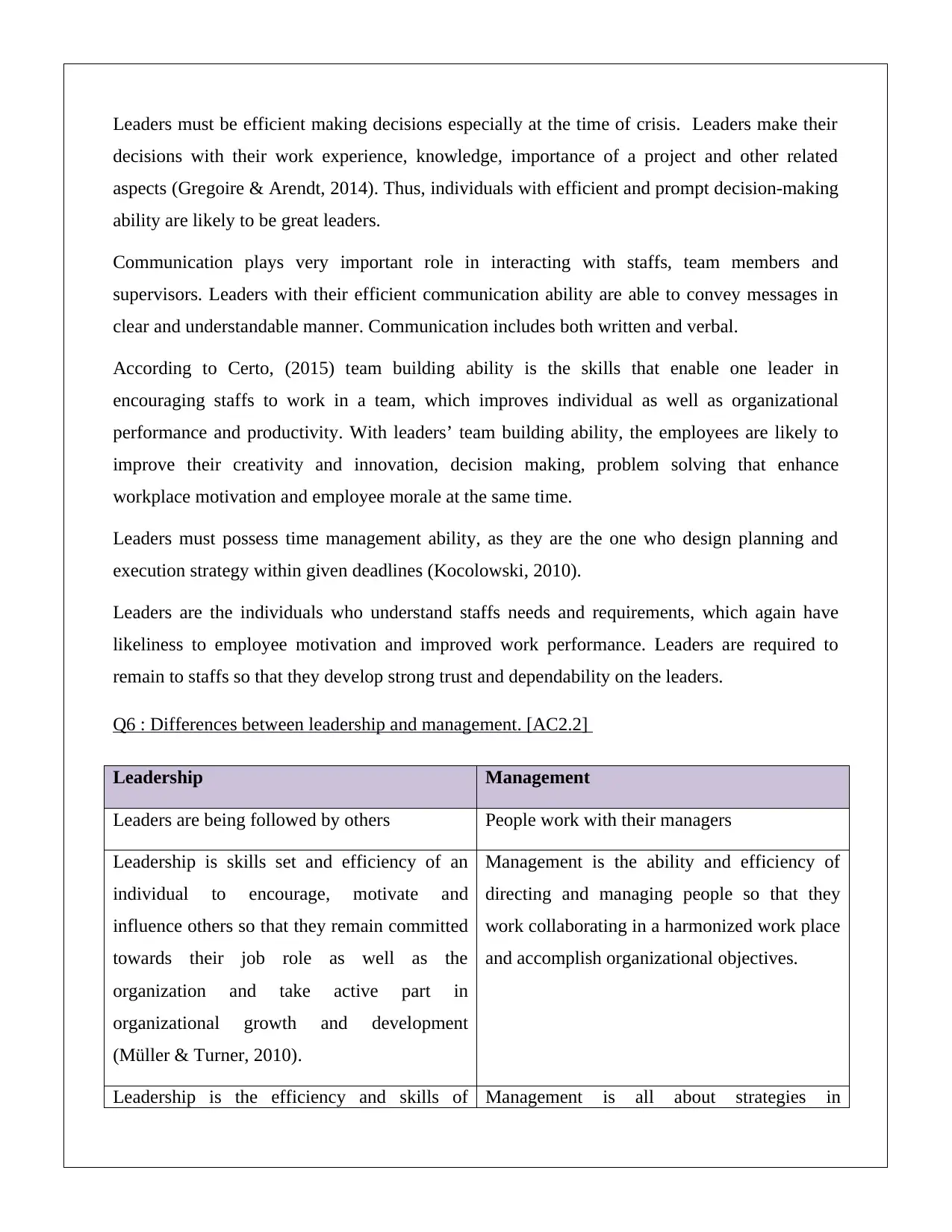
Leaders must be efficient making decisions especially at the time of crisis. Leaders make their
decisions with their work experience, knowledge, importance of a project and other related
aspects (Gregoire & Arendt, 2014). Thus, individuals with efficient and prompt decision-making
ability are likely to be great leaders.
Communication plays very important role in interacting with staffs, team members and
supervisors. Leaders with their efficient communication ability are able to convey messages in
clear and understandable manner. Communication includes both written and verbal.
According to Certo, (2015) team building ability is the skills that enable one leader in
encouraging staffs to work in a team, which improves individual as well as organizational
performance and productivity. With leaders’ team building ability, the employees are likely to
improve their creativity and innovation, decision making, problem solving that enhance
workplace motivation and employee morale at the same time.
Leaders must possess time management ability, as they are the one who design planning and
execution strategy within given deadlines (Kocolowski, 2010).
Leaders are the individuals who understand staffs needs and requirements, which again have
likeliness to employee motivation and improved work performance. Leaders are required to
remain to staffs so that they develop strong trust and dependability on the leaders.
Q6 : Differences between leadership and management. [AC2.2]
Leadership Management
Leaders are being followed by others People work with their managers
Leadership is skills set and efficiency of an
individual to encourage, motivate and
influence others so that they remain committed
towards their job role as well as the
organization and take active part in
organizational growth and development
(Müller & Turner, 2010).
Management is the ability and efficiency of
directing and managing people so that they
work collaborating in a harmonized work place
and accomplish organizational objectives.
Leadership is the efficiency and skills of Management is all about strategies in
decisions with their work experience, knowledge, importance of a project and other related
aspects (Gregoire & Arendt, 2014). Thus, individuals with efficient and prompt decision-making
ability are likely to be great leaders.
Communication plays very important role in interacting with staffs, team members and
supervisors. Leaders with their efficient communication ability are able to convey messages in
clear and understandable manner. Communication includes both written and verbal.
According to Certo, (2015) team building ability is the skills that enable one leader in
encouraging staffs to work in a team, which improves individual as well as organizational
performance and productivity. With leaders’ team building ability, the employees are likely to
improve their creativity and innovation, decision making, problem solving that enhance
workplace motivation and employee morale at the same time.
Leaders must possess time management ability, as they are the one who design planning and
execution strategy within given deadlines (Kocolowski, 2010).
Leaders are the individuals who understand staffs needs and requirements, which again have
likeliness to employee motivation and improved work performance. Leaders are required to
remain to staffs so that they develop strong trust and dependability on the leaders.
Q6 : Differences between leadership and management. [AC2.2]
Leadership Management
Leaders are being followed by others People work with their managers
Leadership is skills set and efficiency of an
individual to encourage, motivate and
influence others so that they remain committed
towards their job role as well as the
organization and take active part in
organizational growth and development
(Müller & Turner, 2010).
Management is the ability and efficiency of
directing and managing people so that they
work collaborating in a harmonized work place
and accomplish organizational objectives.
Leadership is the efficiency and skills of Management is all about strategies in
Paraphrase This Document
Need a fresh take? Get an instant paraphrase of this document with our AI Paraphraser
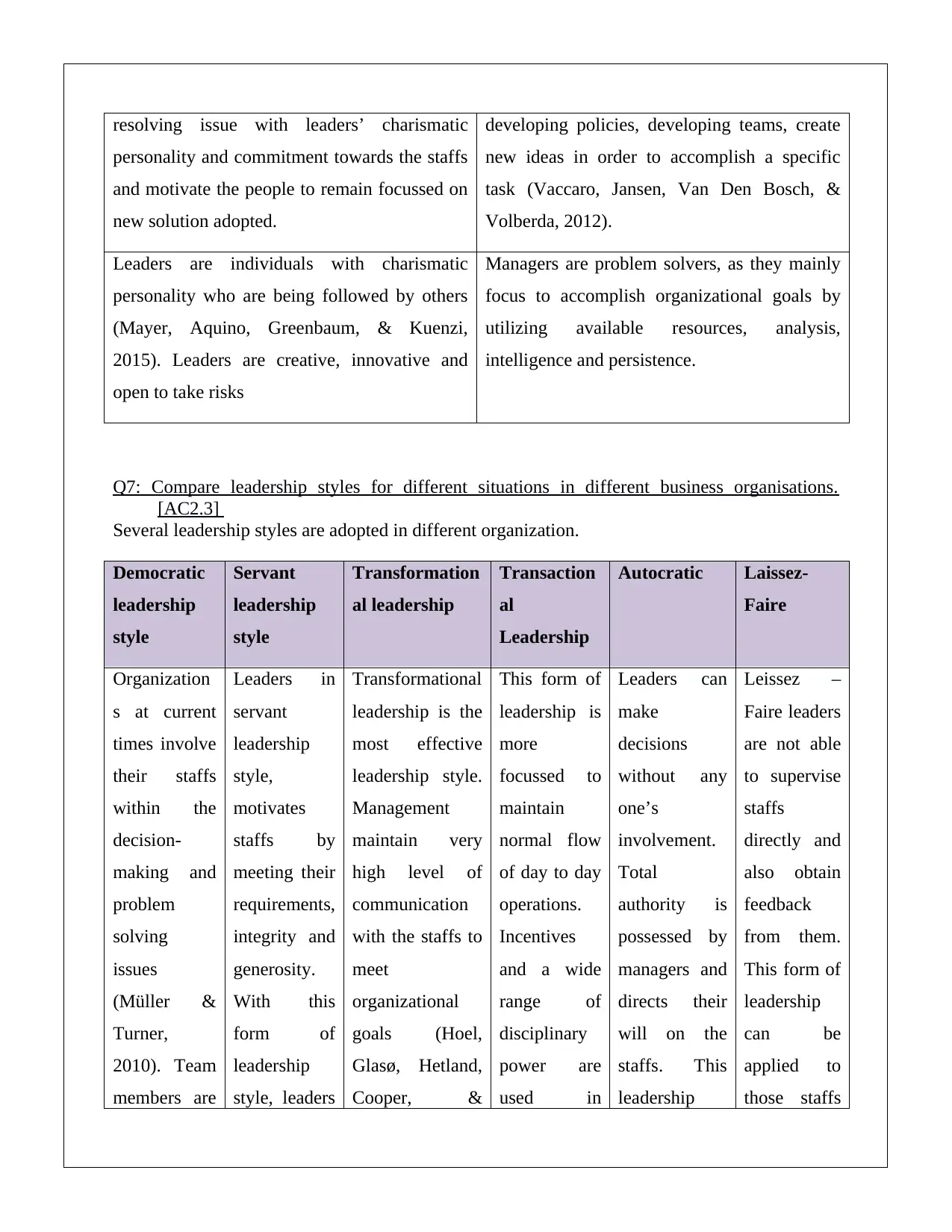
resolving issue with leaders’ charismatic
personality and commitment towards the staffs
and motivate the people to remain focussed on
new solution adopted.
developing policies, developing teams, create
new ideas in order to accomplish a specific
task (Vaccaro, Jansen, Van Den Bosch, &
Volberda, 2012).
Leaders are individuals with charismatic
personality who are being followed by others
(Mayer, Aquino, Greenbaum, & Kuenzi,
2015). Leaders are creative, innovative and
open to take risks
Managers are problem solvers, as they mainly
focus to accomplish organizational goals by
utilizing available resources, analysis,
intelligence and persistence.
Q7: Compare leadership styles for different situations in different business organisations.
[AC2.3]
Several leadership styles are adopted in different organization.
Democratic
leadership
style
Servant
leadership
style
Transformation
al leadership
Transaction
al
Leadership
Autocratic Laissez-
Faire
Organization
s at current
times involve
their staffs
within the
decision-
making and
problem
solving
issues
(Müller &
Turner,
2010). Team
members are
Leaders in
servant
leadership
style,
motivates
staffs by
meeting their
requirements,
integrity and
generosity.
With this
form of
leadership
style, leaders
Transformational
leadership is the
most effective
leadership style.
Management
maintain very
high level of
communication
with the staffs to
meet
organizational
goals (Hoel,
Glasø, Hetland,
Cooper, &
This form of
leadership is
more
focussed to
maintain
normal flow
of day to day
operations.
Incentives
and a wide
range of
disciplinary
power are
used in
Leaders can
make
decisions
without any
one’s
involvement.
Total
authority is
possessed by
managers and
directs their
will on the
staffs. This
leadership
Leissez –
Faire leaders
are not able
to supervise
staffs
directly and
also obtain
feedback
from them.
This form of
leadership
can be
applied to
those staffs
personality and commitment towards the staffs
and motivate the people to remain focussed on
new solution adopted.
developing policies, developing teams, create
new ideas in order to accomplish a specific
task (Vaccaro, Jansen, Van Den Bosch, &
Volberda, 2012).
Leaders are individuals with charismatic
personality who are being followed by others
(Mayer, Aquino, Greenbaum, & Kuenzi,
2015). Leaders are creative, innovative and
open to take risks
Managers are problem solvers, as they mainly
focus to accomplish organizational goals by
utilizing available resources, analysis,
intelligence and persistence.
Q7: Compare leadership styles for different situations in different business organisations.
[AC2.3]
Several leadership styles are adopted in different organization.
Democratic
leadership
style
Servant
leadership
style
Transformation
al leadership
Transaction
al
Leadership
Autocratic Laissez-
Faire
Organization
s at current
times involve
their staffs
within the
decision-
making and
problem
solving
issues
(Müller &
Turner,
2010). Team
members are
Leaders in
servant
leadership
style,
motivates
staffs by
meeting their
requirements,
integrity and
generosity.
With this
form of
leadership
style, leaders
Transformational
leadership is the
most effective
leadership style.
Management
maintain very
high level of
communication
with the staffs to
meet
organizational
goals (Hoel,
Glasø, Hetland,
Cooper, &
This form of
leadership is
more
focussed to
maintain
normal flow
of day to day
operations.
Incentives
and a wide
range of
disciplinary
power are
used in
Leaders can
make
decisions
without any
one’s
involvement.
Total
authority is
possessed by
managers and
directs their
will on the
staffs. This
leadership
Leissez –
Faire leaders
are not able
to supervise
staffs
directly and
also obtain
feedback
from them.
This form of
leadership
can be
applied to
those staffs
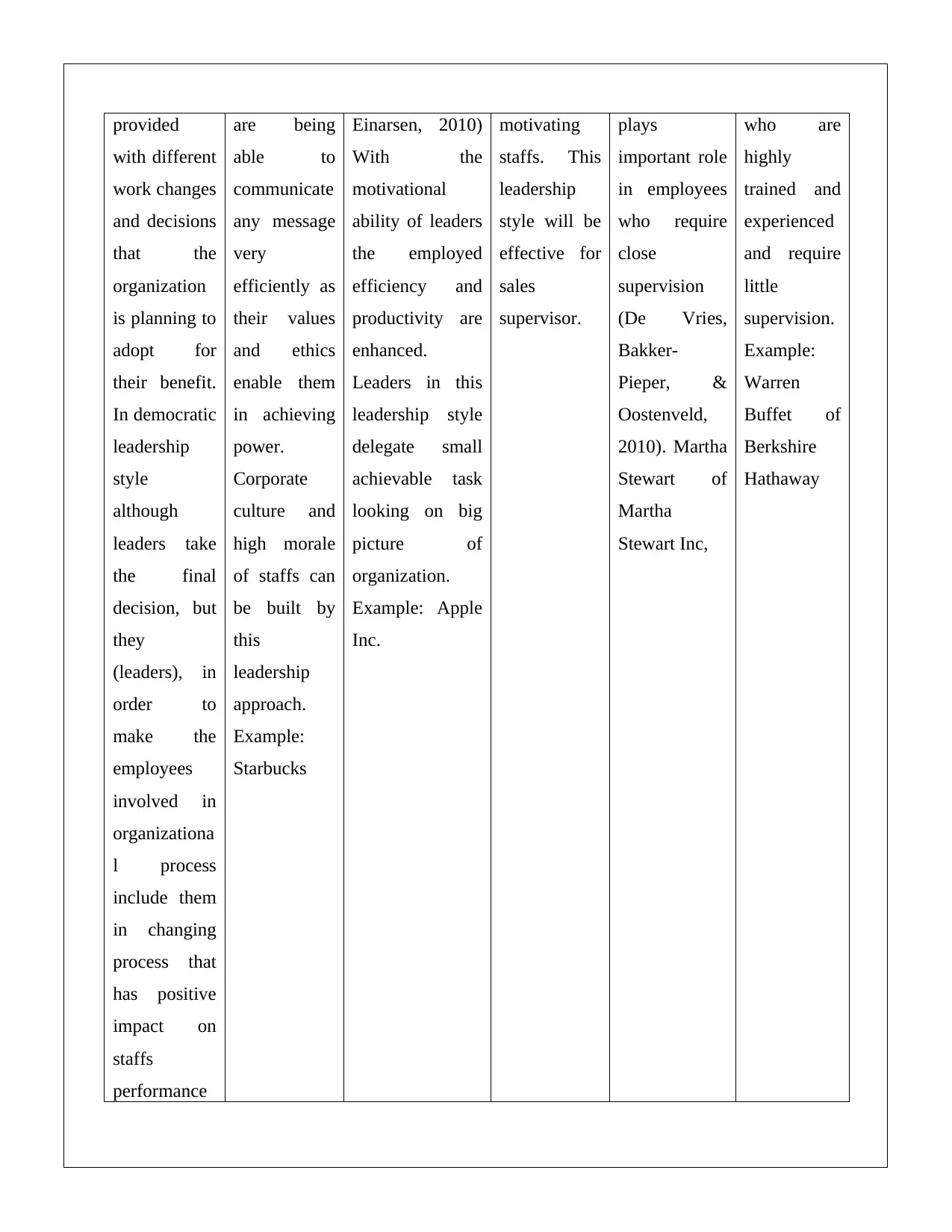
provided
with different
work changes
and decisions
that the
organization
is planning to
adopt for
their benefit.
In democratic
leadership
style
although
leaders take
the final
decision, but
they
(leaders), in
order to
make the
employees
involved in
organizationa
l process
include them
in changing
process that
has positive
impact on
staffs
performance
are being
able to
communicate
any message
very
efficiently as
their values
and ethics
enable them
in achieving
power.
Corporate
culture and
high morale
of staffs can
be built by
this
leadership
approach.
Example:
Starbucks
Einarsen, 2010)
With the
motivational
ability of leaders
the employed
efficiency and
productivity are
enhanced.
Leaders in this
leadership style
delegate small
achievable task
looking on big
picture of
organization.
Example: Apple
Inc.
motivating
staffs. This
leadership
style will be
effective for
sales
supervisor.
plays
important role
in employees
who require
close
supervision
(De Vries,
Bakker-
Pieper, &
Oostenveld,
2010). Martha
Stewart of
Martha
Stewart Inc,
who are
highly
trained and
experienced
and require
little
supervision.
Example:
Warren
Buffet of
Berkshire
Hathaway
with different
work changes
and decisions
that the
organization
is planning to
adopt for
their benefit.
In democratic
leadership
style
although
leaders take
the final
decision, but
they
(leaders), in
order to
make the
employees
involved in
organizationa
l process
include them
in changing
process that
has positive
impact on
staffs
performance
are being
able to
communicate
any message
very
efficiently as
their values
and ethics
enable them
in achieving
power.
Corporate
culture and
high morale
of staffs can
be built by
this
leadership
approach.
Example:
Starbucks
Einarsen, 2010)
With the
motivational
ability of leaders
the employed
efficiency and
productivity are
enhanced.
Leaders in this
leadership style
delegate small
achievable task
looking on big
picture of
organization.
Example: Apple
Inc.
motivating
staffs. This
leadership
style will be
effective for
sales
supervisor.
plays
important role
in employees
who require
close
supervision
(De Vries,
Bakker-
Pieper, &
Oostenveld,
2010). Martha
Stewart of
Martha
Stewart Inc,
who are
highly
trained and
experienced
and require
little
supervision.
Example:
Warren
Buffet of
Berkshire
Hathaway
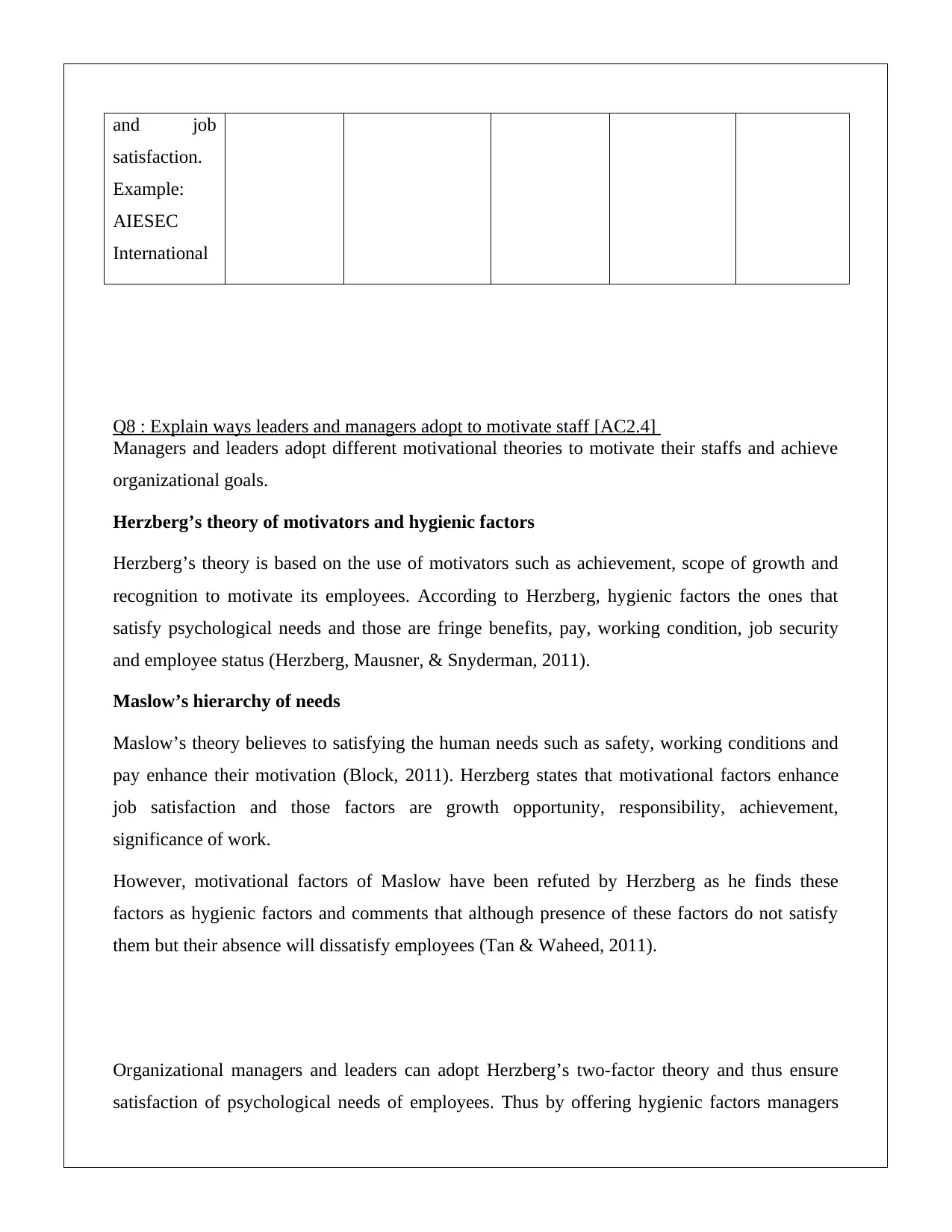
and job
satisfaction.
Example:
AIESEC
International
Q8 : Explain ways leaders and managers adopt to motivate staff [AC2.4]
Managers and leaders adopt different motivational theories to motivate their staffs and achieve
organizational goals.
Herzberg’s theory of motivators and hygienic factors
Herzberg’s theory is based on the use of motivators such as achievement, scope of growth and
recognition to motivate its employees. According to Herzberg, hygienic factors the ones that
satisfy psychological needs and those are fringe benefits, pay, working condition, job security
and employee status (Herzberg, Mausner, & Snyderman, 2011).
Maslow’s hierarchy of needs
Maslow’s theory believes to satisfying the human needs such as safety, working conditions and
pay enhance their motivation (Block, 2011). Herzberg states that motivational factors enhance
job satisfaction and those factors are growth opportunity, responsibility, achievement,
significance of work.
However, motivational factors of Maslow have been refuted by Herzberg as he finds these
factors as hygienic factors and comments that although presence of these factors do not satisfy
them but their absence will dissatisfy employees (Tan & Waheed, 2011).
Organizational managers and leaders can adopt Herzberg’s two-factor theory and thus ensure
satisfaction of psychological needs of employees. Thus by offering hygienic factors managers
satisfaction.
Example:
AIESEC
International
Q8 : Explain ways leaders and managers adopt to motivate staff [AC2.4]
Managers and leaders adopt different motivational theories to motivate their staffs and achieve
organizational goals.
Herzberg’s theory of motivators and hygienic factors
Herzberg’s theory is based on the use of motivators such as achievement, scope of growth and
recognition to motivate its employees. According to Herzberg, hygienic factors the ones that
satisfy psychological needs and those are fringe benefits, pay, working condition, job security
and employee status (Herzberg, Mausner, & Snyderman, 2011).
Maslow’s hierarchy of needs
Maslow’s theory believes to satisfying the human needs such as safety, working conditions and
pay enhance their motivation (Block, 2011). Herzberg states that motivational factors enhance
job satisfaction and those factors are growth opportunity, responsibility, achievement,
significance of work.
However, motivational factors of Maslow have been refuted by Herzberg as he finds these
factors as hygienic factors and comments that although presence of these factors do not satisfy
them but their absence will dissatisfy employees (Tan & Waheed, 2011).
Organizational managers and leaders can adopt Herzberg’s two-factor theory and thus ensure
satisfaction of psychological needs of employees. Thus by offering hygienic factors managers
Secure Best Marks with AI Grader
Need help grading? Try our AI Grader for instant feedback on your assignments.
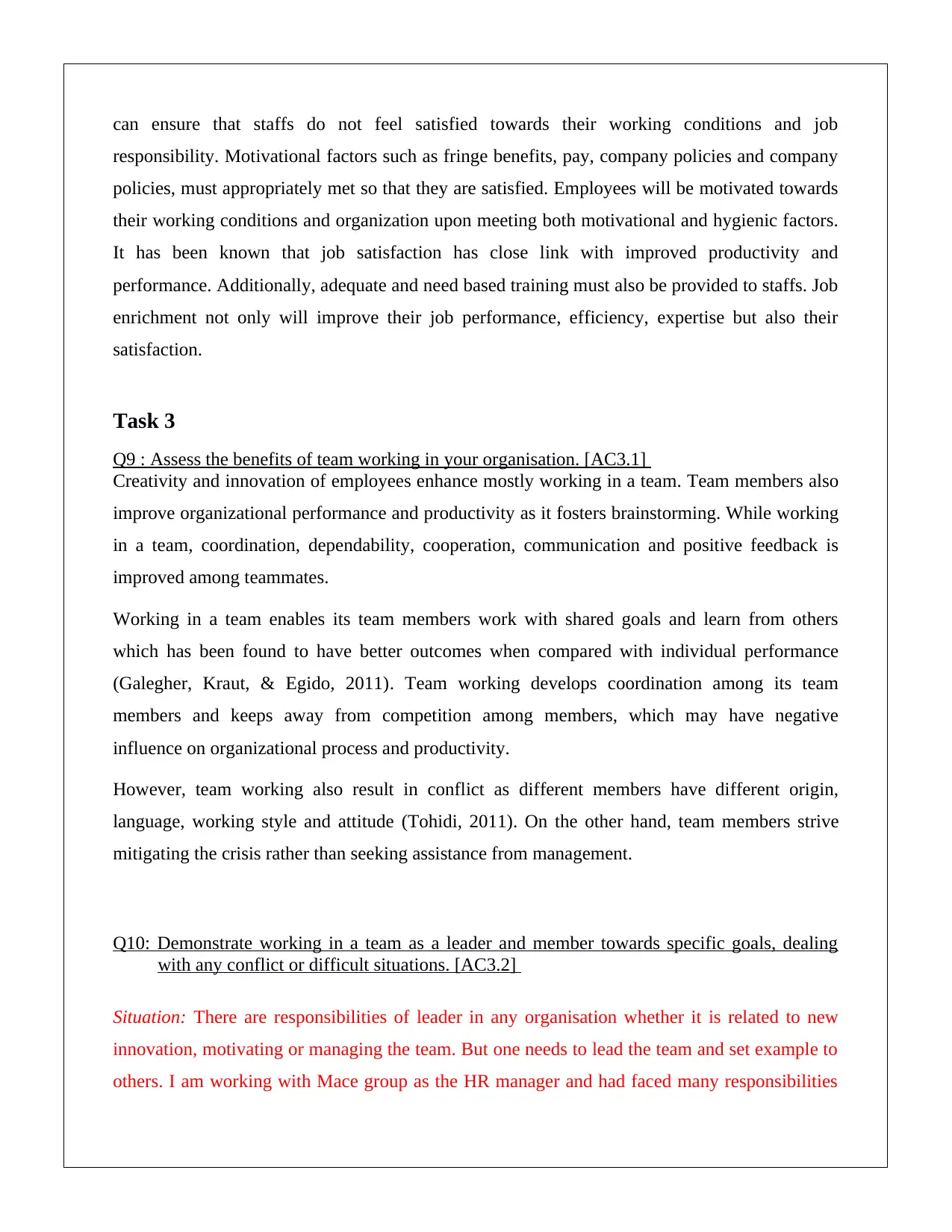
can ensure that staffs do not feel satisfied towards their working conditions and job
responsibility. Motivational factors such as fringe benefits, pay, company policies and company
policies, must appropriately met so that they are satisfied. Employees will be motivated towards
their working conditions and organization upon meeting both motivational and hygienic factors.
It has been known that job satisfaction has close link with improved productivity and
performance. Additionally, adequate and need based training must also be provided to staffs. Job
enrichment not only will improve their job performance, efficiency, expertise but also their
satisfaction.
Task 3
Q9 : Assess the benefits of team working in your organisation. [AC3.1]
Creativity and innovation of employees enhance mostly working in a team. Team members also
improve organizational performance and productivity as it fosters brainstorming. While working
in a team, coordination, dependability, cooperation, communication and positive feedback is
improved among teammates.
Working in a team enables its team members work with shared goals and learn from others
which has been found to have better outcomes when compared with individual performance
(Galegher, Kraut, & Egido, 2011). Team working develops coordination among its team
members and keeps away from competition among members, which may have negative
influence on organizational process and productivity.
However, team working also result in conflict as different members have different origin,
language, working style and attitude (Tohidi, 2011). On the other hand, team members strive
mitigating the crisis rather than seeking assistance from management.
Q10: Demonstrate working in a team as a leader and member towards specific goals, dealing
with any conflict or difficult situations. [AC3.2]
Situation: There are responsibilities of leader in any organisation whether it is related to new
innovation, motivating or managing the team. But one needs to lead the team and set example to
others. I am working with Mace group as the HR manager and had faced many responsibilities
responsibility. Motivational factors such as fringe benefits, pay, company policies and company
policies, must appropriately met so that they are satisfied. Employees will be motivated towards
their working conditions and organization upon meeting both motivational and hygienic factors.
It has been known that job satisfaction has close link with improved productivity and
performance. Additionally, adequate and need based training must also be provided to staffs. Job
enrichment not only will improve their job performance, efficiency, expertise but also their
satisfaction.
Task 3
Q9 : Assess the benefits of team working in your organisation. [AC3.1]
Creativity and innovation of employees enhance mostly working in a team. Team members also
improve organizational performance and productivity as it fosters brainstorming. While working
in a team, coordination, dependability, cooperation, communication and positive feedback is
improved among teammates.
Working in a team enables its team members work with shared goals and learn from others
which has been found to have better outcomes when compared with individual performance
(Galegher, Kraut, & Egido, 2011). Team working develops coordination among its team
members and keeps away from competition among members, which may have negative
influence on organizational process and productivity.
However, team working also result in conflict as different members have different origin,
language, working style and attitude (Tohidi, 2011). On the other hand, team members strive
mitigating the crisis rather than seeking assistance from management.
Q10: Demonstrate working in a team as a leader and member towards specific goals, dealing
with any conflict or difficult situations. [AC3.2]
Situation: There are responsibilities of leader in any organisation whether it is related to new
innovation, motivating or managing the team. But one needs to lead the team and set example to
others. I am working with Mace group as the HR manager and had faced many responsibilities
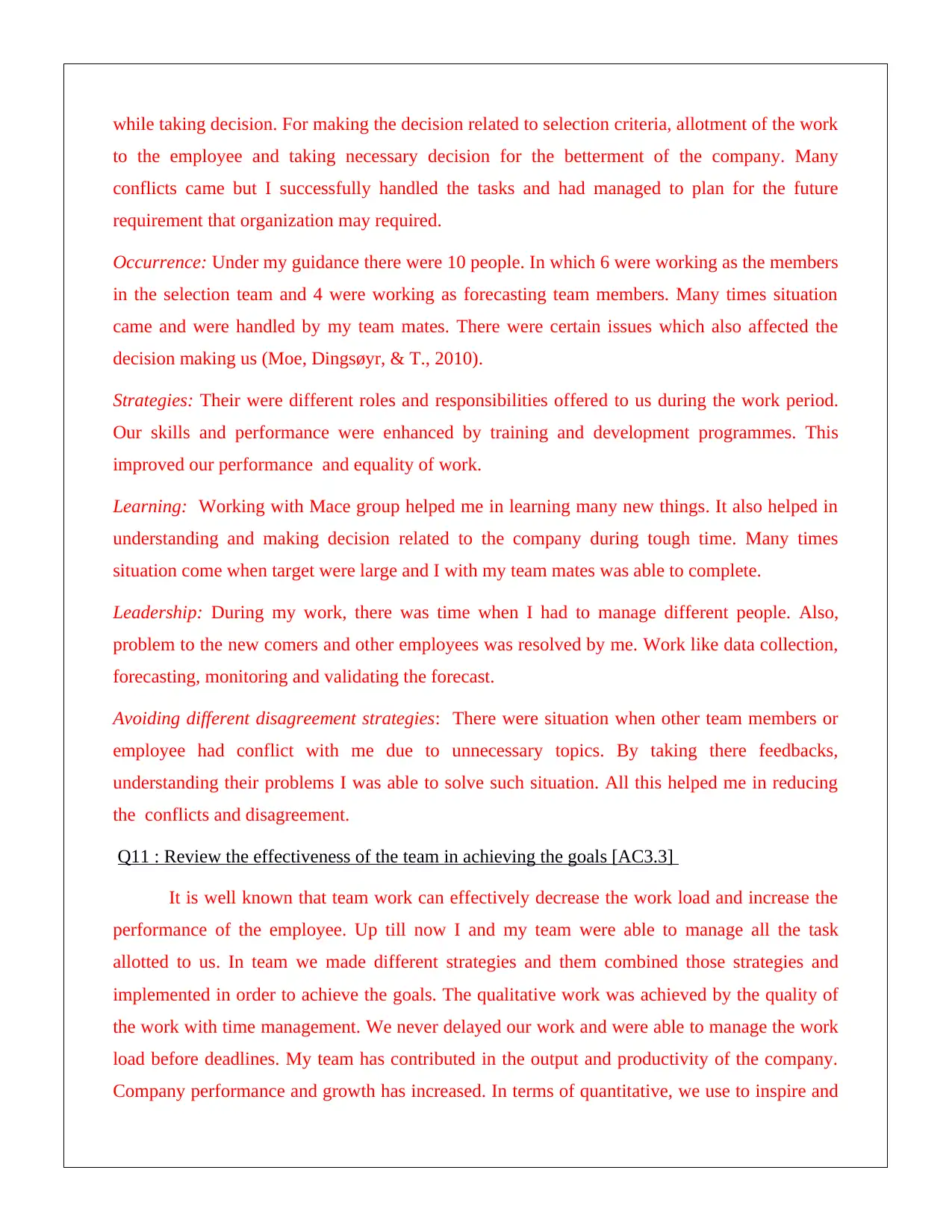
while taking decision. For making the decision related to selection criteria, allotment of the work
to the employee and taking necessary decision for the betterment of the company. Many
conflicts came but I successfully handled the tasks and had managed to plan for the future
requirement that organization may required.
Occurrence: Under my guidance there were 10 people. In which 6 were working as the members
in the selection team and 4 were working as forecasting team members. Many times situation
came and were handled by my team mates. There were certain issues which also affected the
decision making us (Moe, Dingsøyr, & T., 2010).
Strategies: Their were different roles and responsibilities offered to us during the work period.
Our skills and performance were enhanced by training and development programmes. This
improved our performance and equality of work.
Learning: Working with Mace group helped me in learning many new things. It also helped in
understanding and making decision related to the company during tough time. Many times
situation come when target were large and I with my team mates was able to complete.
Leadership: During my work, there was time when I had to manage different people. Also,
problem to the new comers and other employees was resolved by me. Work like data collection,
forecasting, monitoring and validating the forecast.
Avoiding different disagreement strategies: There were situation when other team members or
employee had conflict with me due to unnecessary topics. By taking there feedbacks,
understanding their problems I was able to solve such situation. All this helped me in reducing
the conflicts and disagreement.
Q11 : Review the effectiveness of the team in achieving the goals [AC3.3]
It is well known that team work can effectively decrease the work load and increase the
performance of the employee. Up till now I and my team were able to manage all the task
allotted to us. In team we made different strategies and them combined those strategies and
implemented in order to achieve the goals. The qualitative work was achieved by the quality of
the work with time management. We never delayed our work and were able to manage the work
load before deadlines. My team has contributed in the output and productivity of the company.
Company performance and growth has increased. In terms of quantitative, we use to inspire and
to the employee and taking necessary decision for the betterment of the company. Many
conflicts came but I successfully handled the tasks and had managed to plan for the future
requirement that organization may required.
Occurrence: Under my guidance there were 10 people. In which 6 were working as the members
in the selection team and 4 were working as forecasting team members. Many times situation
came and were handled by my team mates. There were certain issues which also affected the
decision making us (Moe, Dingsøyr, & T., 2010).
Strategies: Their were different roles and responsibilities offered to us during the work period.
Our skills and performance were enhanced by training and development programmes. This
improved our performance and equality of work.
Learning: Working with Mace group helped me in learning many new things. It also helped in
understanding and making decision related to the company during tough time. Many times
situation come when target were large and I with my team mates was able to complete.
Leadership: During my work, there was time when I had to manage different people. Also,
problem to the new comers and other employees was resolved by me. Work like data collection,
forecasting, monitoring and validating the forecast.
Avoiding different disagreement strategies: There were situation when other team members or
employee had conflict with me due to unnecessary topics. By taking there feedbacks,
understanding their problems I was able to solve such situation. All this helped me in reducing
the conflicts and disagreement.
Q11 : Review the effectiveness of the team in achieving the goals [AC3.3]
It is well known that team work can effectively decrease the work load and increase the
performance of the employee. Up till now I and my team were able to manage all the task
allotted to us. In team we made different strategies and them combined those strategies and
implemented in order to achieve the goals. The qualitative work was achieved by the quality of
the work with time management. We never delayed our work and were able to manage the work
load before deadlines. My team has contributed in the output and productivity of the company.
Company performance and growth has increased. In terms of quantitative, we use to inspire and
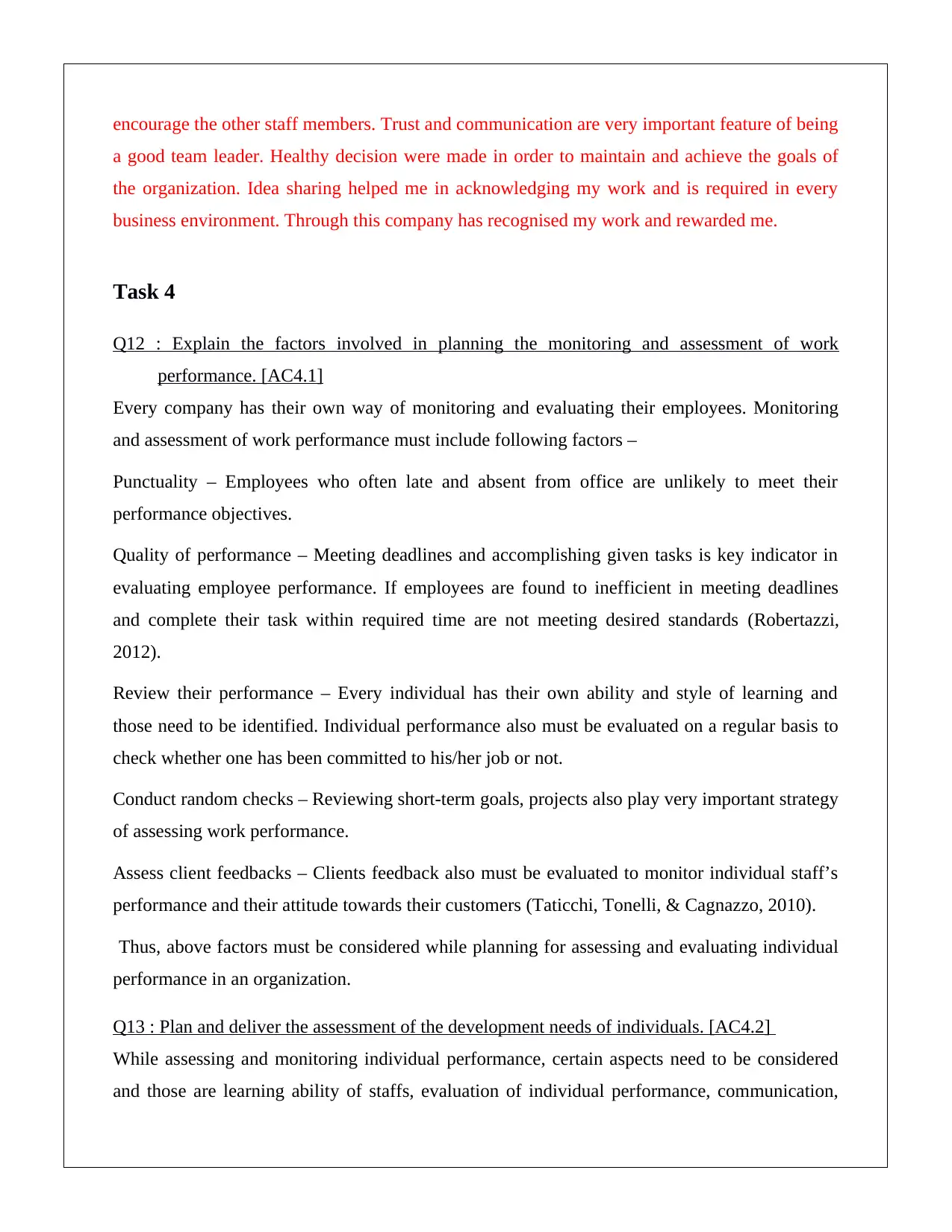
encourage the other staff members. Trust and communication are very important feature of being
a good team leader. Healthy decision were made in order to maintain and achieve the goals of
the organization. Idea sharing helped me in acknowledging my work and is required in every
business environment. Through this company has recognised my work and rewarded me.
Task 4
Q12 : Explain the factors involved in planning the monitoring and assessment of work
performance. [AC4.1]
Every company has their own way of monitoring and evaluating their employees. Monitoring
and assessment of work performance must include following factors –
Punctuality – Employees who often late and absent from office are unlikely to meet their
performance objectives.
Quality of performance – Meeting deadlines and accomplishing given tasks is key indicator in
evaluating employee performance. If employees are found to inefficient in meeting deadlines
and complete their task within required time are not meeting desired standards (Robertazzi,
2012).
Review their performance – Every individual has their own ability and style of learning and
those need to be identified. Individual performance also must be evaluated on a regular basis to
check whether one has been committed to his/her job or not.
Conduct random checks – Reviewing short-term goals, projects also play very important strategy
of assessing work performance.
Assess client feedbacks – Clients feedback also must be evaluated to monitor individual staff’s
performance and their attitude towards their customers (Taticchi, Tonelli, & Cagnazzo, 2010).
Thus, above factors must be considered while planning for assessing and evaluating individual
performance in an organization.
Q13 : Plan and deliver the assessment of the development needs of individuals. [AC4.2]
While assessing and monitoring individual performance, certain aspects need to be considered
and those are learning ability of staffs, evaluation of individual performance, communication,
a good team leader. Healthy decision were made in order to maintain and achieve the goals of
the organization. Idea sharing helped me in acknowledging my work and is required in every
business environment. Through this company has recognised my work and rewarded me.
Task 4
Q12 : Explain the factors involved in planning the monitoring and assessment of work
performance. [AC4.1]
Every company has their own way of monitoring and evaluating their employees. Monitoring
and assessment of work performance must include following factors –
Punctuality – Employees who often late and absent from office are unlikely to meet their
performance objectives.
Quality of performance – Meeting deadlines and accomplishing given tasks is key indicator in
evaluating employee performance. If employees are found to inefficient in meeting deadlines
and complete their task within required time are not meeting desired standards (Robertazzi,
2012).
Review their performance – Every individual has their own ability and style of learning and
those need to be identified. Individual performance also must be evaluated on a regular basis to
check whether one has been committed to his/her job or not.
Conduct random checks – Reviewing short-term goals, projects also play very important strategy
of assessing work performance.
Assess client feedbacks – Clients feedback also must be evaluated to monitor individual staff’s
performance and their attitude towards their customers (Taticchi, Tonelli, & Cagnazzo, 2010).
Thus, above factors must be considered while planning for assessing and evaluating individual
performance in an organization.
Q13 : Plan and deliver the assessment of the development needs of individuals. [AC4.2]
While assessing and monitoring individual performance, certain aspects need to be considered
and those are learning ability of staffs, evaluation of individual performance, communication,
Paraphrase This Document
Need a fresh take? Get an instant paraphrase of this document with our AI Paraphraser
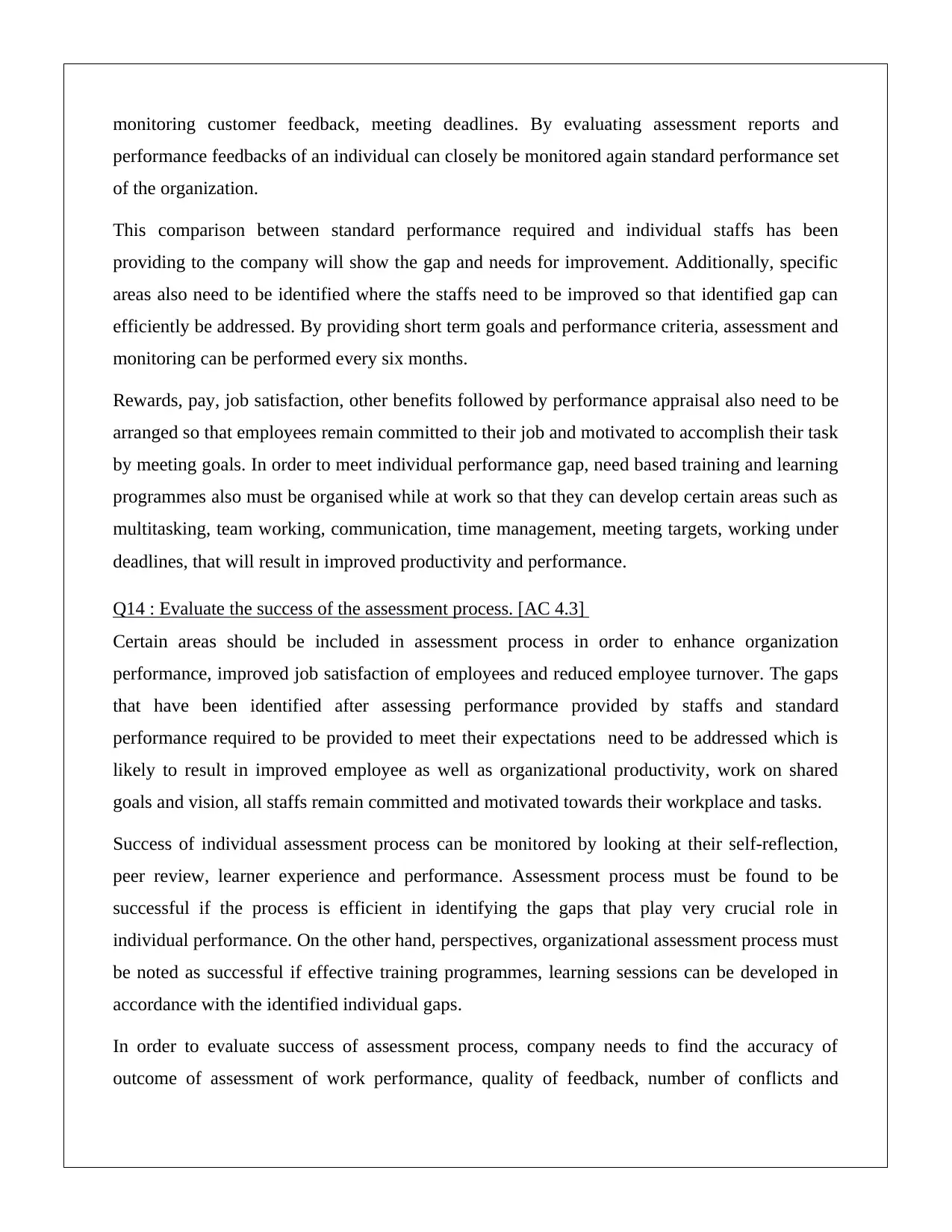
monitoring customer feedback, meeting deadlines. By evaluating assessment reports and
performance feedbacks of an individual can closely be monitored again standard performance set
of the organization.
This comparison between standard performance required and individual staffs has been
providing to the company will show the gap and needs for improvement. Additionally, specific
areas also need to be identified where the staffs need to be improved so that identified gap can
efficiently be addressed. By providing short term goals and performance criteria, assessment and
monitoring can be performed every six months.
Rewards, pay, job satisfaction, other benefits followed by performance appraisal also need to be
arranged so that employees remain committed to their job and motivated to accomplish their task
by meeting goals. In order to meet individual performance gap, need based training and learning
programmes also must be organised while at work so that they can develop certain areas such as
multitasking, team working, communication, time management, meeting targets, working under
deadlines, that will result in improved productivity and performance.
Q14 : Evaluate the success of the assessment process. [AC 4.3]
Certain areas should be included in assessment process in order to enhance organization
performance, improved job satisfaction of employees and reduced employee turnover. The gaps
that have been identified after assessing performance provided by staffs and standard
performance required to be provided to meet their expectations need to be addressed which is
likely to result in improved employee as well as organizational productivity, work on shared
goals and vision, all staffs remain committed and motivated towards their workplace and tasks.
Success of individual assessment process can be monitored by looking at their self-reflection,
peer review, learner experience and performance. Assessment process must be found to be
successful if the process is efficient in identifying the gaps that play very crucial role in
individual performance. On the other hand, perspectives, organizational assessment process must
be noted as successful if effective training programmes, learning sessions can be developed in
accordance with the identified individual gaps.
In order to evaluate success of assessment process, company needs to find the accuracy of
outcome of assessment of work performance, quality of feedback, number of conflicts and
performance feedbacks of an individual can closely be monitored again standard performance set
of the organization.
This comparison between standard performance required and individual staffs has been
providing to the company will show the gap and needs for improvement. Additionally, specific
areas also need to be identified where the staffs need to be improved so that identified gap can
efficiently be addressed. By providing short term goals and performance criteria, assessment and
monitoring can be performed every six months.
Rewards, pay, job satisfaction, other benefits followed by performance appraisal also need to be
arranged so that employees remain committed to their job and motivated to accomplish their task
by meeting goals. In order to meet individual performance gap, need based training and learning
programmes also must be organised while at work so that they can develop certain areas such as
multitasking, team working, communication, time management, meeting targets, working under
deadlines, that will result in improved productivity and performance.
Q14 : Evaluate the success of the assessment process. [AC 4.3]
Certain areas should be included in assessment process in order to enhance organization
performance, improved job satisfaction of employees and reduced employee turnover. The gaps
that have been identified after assessing performance provided by staffs and standard
performance required to be provided to meet their expectations need to be addressed which is
likely to result in improved employee as well as organizational productivity, work on shared
goals and vision, all staffs remain committed and motivated towards their workplace and tasks.
Success of individual assessment process can be monitored by looking at their self-reflection,
peer review, learner experience and performance. Assessment process must be found to be
successful if the process is efficient in identifying the gaps that play very crucial role in
individual performance. On the other hand, perspectives, organizational assessment process must
be noted as successful if effective training programmes, learning sessions can be developed in
accordance with the identified individual gaps.
In order to evaluate success of assessment process, company needs to find the accuracy of
outcome of assessment of work performance, quality of feedback, number of conflicts and
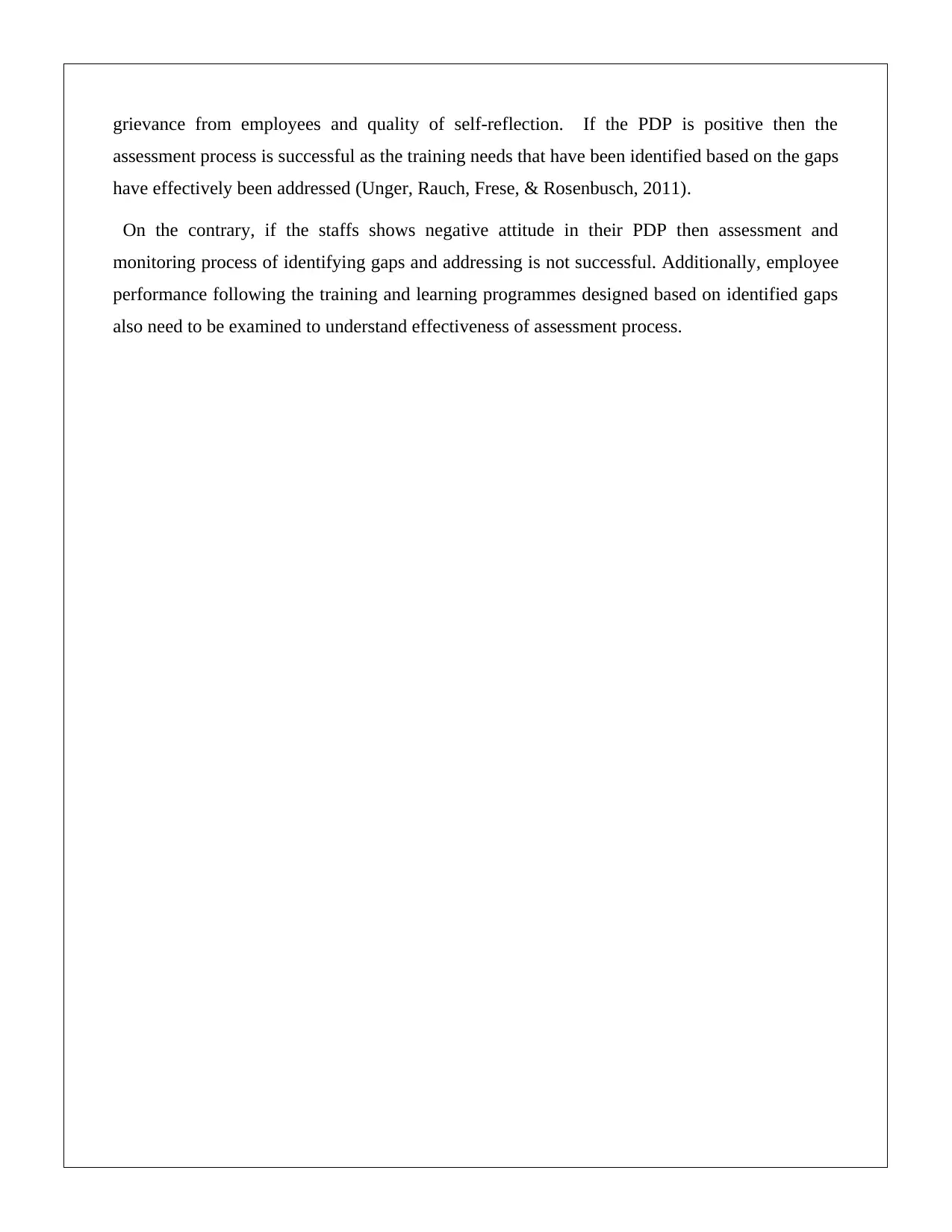
grievance from employees and quality of self-reflection. If the PDP is positive then the
assessment process is successful as the training needs that have been identified based on the gaps
have effectively been addressed (Unger, Rauch, Frese, & Rosenbusch, 2011).
On the contrary, if the staffs shows negative attitude in their PDP then assessment and
monitoring process of identifying gaps and addressing is not successful. Additionally, employee
performance following the training and learning programmes designed based on identified gaps
also need to be examined to understand effectiveness of assessment process.
assessment process is successful as the training needs that have been identified based on the gaps
have effectively been addressed (Unger, Rauch, Frese, & Rosenbusch, 2011).
On the contrary, if the staffs shows negative attitude in their PDP then assessment and
monitoring process of identifying gaps and addressing is not successful. Additionally, employee
performance following the training and learning programmes designed based on identified gaps
also need to be examined to understand effectiveness of assessment process.
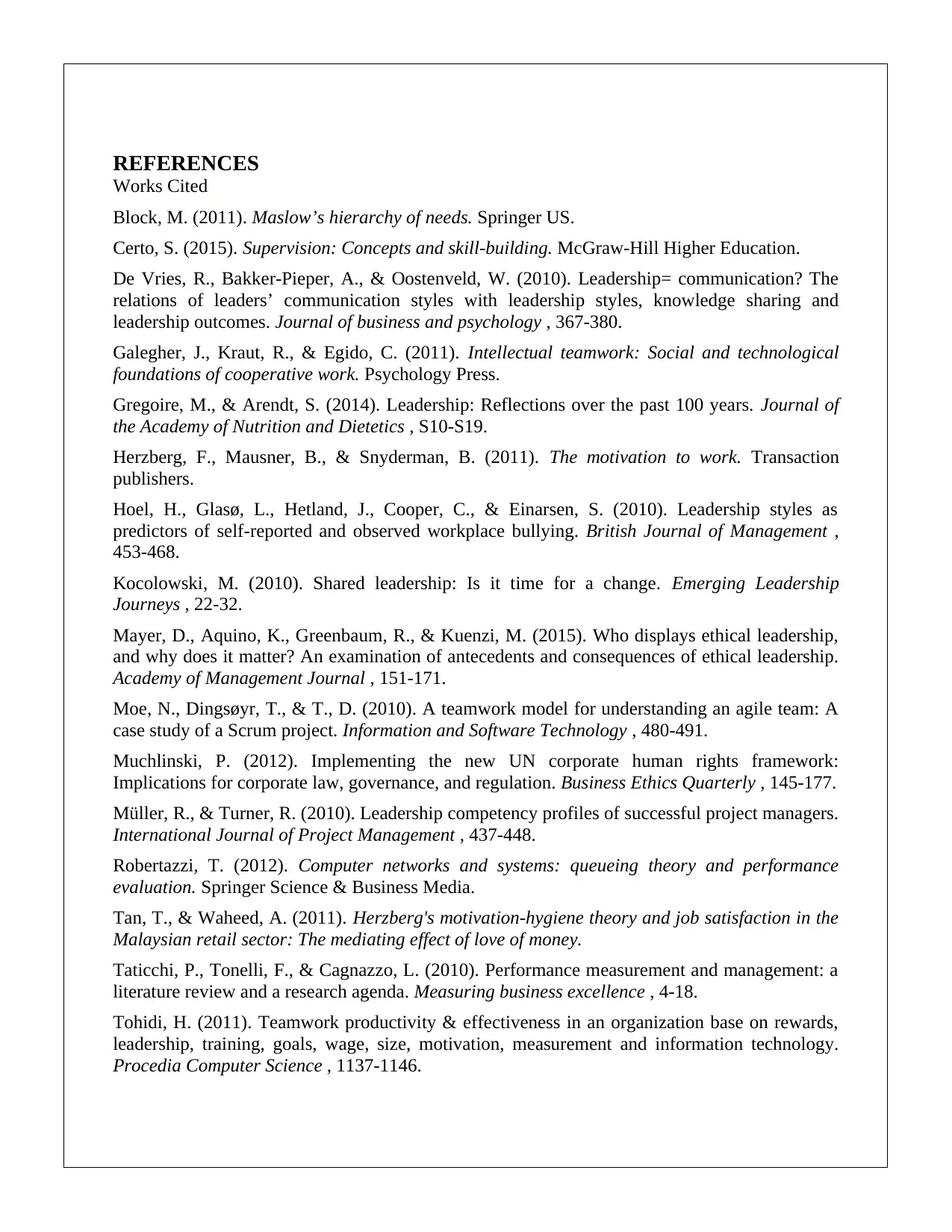
REFERENCES
Works Cited
Block, M. (2011). Maslow’s hierarchy of needs. Springer US.
Certo, S. (2015). Supervision: Concepts and skill-building. McGraw-Hill Higher Education.
De Vries, R., Bakker-Pieper, A., & Oostenveld, W. (2010). Leadership= communication? The
relations of leaders’ communication styles with leadership styles, knowledge sharing and
leadership outcomes. Journal of business and psychology , 367-380.
Galegher, J., Kraut, R., & Egido, C. (2011). Intellectual teamwork: Social and technological
foundations of cooperative work. Psychology Press.
Gregoire, M., & Arendt, S. (2014). Leadership: Reflections over the past 100 years. Journal of
the Academy of Nutrition and Dietetics , S10-S19.
Herzberg, F., Mausner, B., & Snyderman, B. (2011). The motivation to work. Transaction
publishers.
Hoel, H., Glasø, L., Hetland, J., Cooper, C., & Einarsen, S. (2010). Leadership styles as
predictors of self‐reported and observed workplace bullying. British Journal of Management ,
453-468.
Kocolowski, M. (2010). Shared leadership: Is it time for a change. Emerging Leadership
Journeys , 22-32.
Mayer, D., Aquino, K., Greenbaum, R., & Kuenzi, M. (2015). Who displays ethical leadership,
and why does it matter? An examination of antecedents and consequences of ethical leadership.
Academy of Management Journal , 151-171.
Moe, N., Dingsøyr, T., & T., D. (2010). A teamwork model for understanding an agile team: A
case study of a Scrum project. Information and Software Technology , 480-491.
Muchlinski, P. (2012). Implementing the new UN corporate human rights framework:
Implications for corporate law, governance, and regulation. Business Ethics Quarterly , 145-177.
Müller, R., & Turner, R. (2010). Leadership competency profiles of successful project managers.
International Journal of Project Management , 437-448.
Robertazzi, T. (2012). Computer networks and systems: queueing theory and performance
evaluation. Springer Science & Business Media.
Tan, T., & Waheed, A. (2011). Herzberg's motivation-hygiene theory and job satisfaction in the
Malaysian retail sector: The mediating effect of love of money.
Taticchi, P., Tonelli, F., & Cagnazzo, L. (2010). Performance measurement and management: a
literature review and a research agenda. Measuring business excellence , 4-18.
Tohidi, H. (2011). Teamwork productivity & effectiveness in an organization base on rewards,
leadership, training, goals, wage, size, motivation, measurement and information technology.
Procedia Computer Science , 1137-1146.
Works Cited
Block, M. (2011). Maslow’s hierarchy of needs. Springer US.
Certo, S. (2015). Supervision: Concepts and skill-building. McGraw-Hill Higher Education.
De Vries, R., Bakker-Pieper, A., & Oostenveld, W. (2010). Leadership= communication? The
relations of leaders’ communication styles with leadership styles, knowledge sharing and
leadership outcomes. Journal of business and psychology , 367-380.
Galegher, J., Kraut, R., & Egido, C. (2011). Intellectual teamwork: Social and technological
foundations of cooperative work. Psychology Press.
Gregoire, M., & Arendt, S. (2014). Leadership: Reflections over the past 100 years. Journal of
the Academy of Nutrition and Dietetics , S10-S19.
Herzberg, F., Mausner, B., & Snyderman, B. (2011). The motivation to work. Transaction
publishers.
Hoel, H., Glasø, L., Hetland, J., Cooper, C., & Einarsen, S. (2010). Leadership styles as
predictors of self‐reported and observed workplace bullying. British Journal of Management ,
453-468.
Kocolowski, M. (2010). Shared leadership: Is it time for a change. Emerging Leadership
Journeys , 22-32.
Mayer, D., Aquino, K., Greenbaum, R., & Kuenzi, M. (2015). Who displays ethical leadership,
and why does it matter? An examination of antecedents and consequences of ethical leadership.
Academy of Management Journal , 151-171.
Moe, N., Dingsøyr, T., & T., D. (2010). A teamwork model for understanding an agile team: A
case study of a Scrum project. Information and Software Technology , 480-491.
Muchlinski, P. (2012). Implementing the new UN corporate human rights framework:
Implications for corporate law, governance, and regulation. Business Ethics Quarterly , 145-177.
Müller, R., & Turner, R. (2010). Leadership competency profiles of successful project managers.
International Journal of Project Management , 437-448.
Robertazzi, T. (2012). Computer networks and systems: queueing theory and performance
evaluation. Springer Science & Business Media.
Tan, T., & Waheed, A. (2011). Herzberg's motivation-hygiene theory and job satisfaction in the
Malaysian retail sector: The mediating effect of love of money.
Taticchi, P., Tonelli, F., & Cagnazzo, L. (2010). Performance measurement and management: a
literature review and a research agenda. Measuring business excellence , 4-18.
Tohidi, H. (2011). Teamwork productivity & effectiveness in an organization base on rewards,
leadership, training, goals, wage, size, motivation, measurement and information technology.
Procedia Computer Science , 1137-1146.
Secure Best Marks with AI Grader
Need help grading? Try our AI Grader for instant feedback on your assignments.
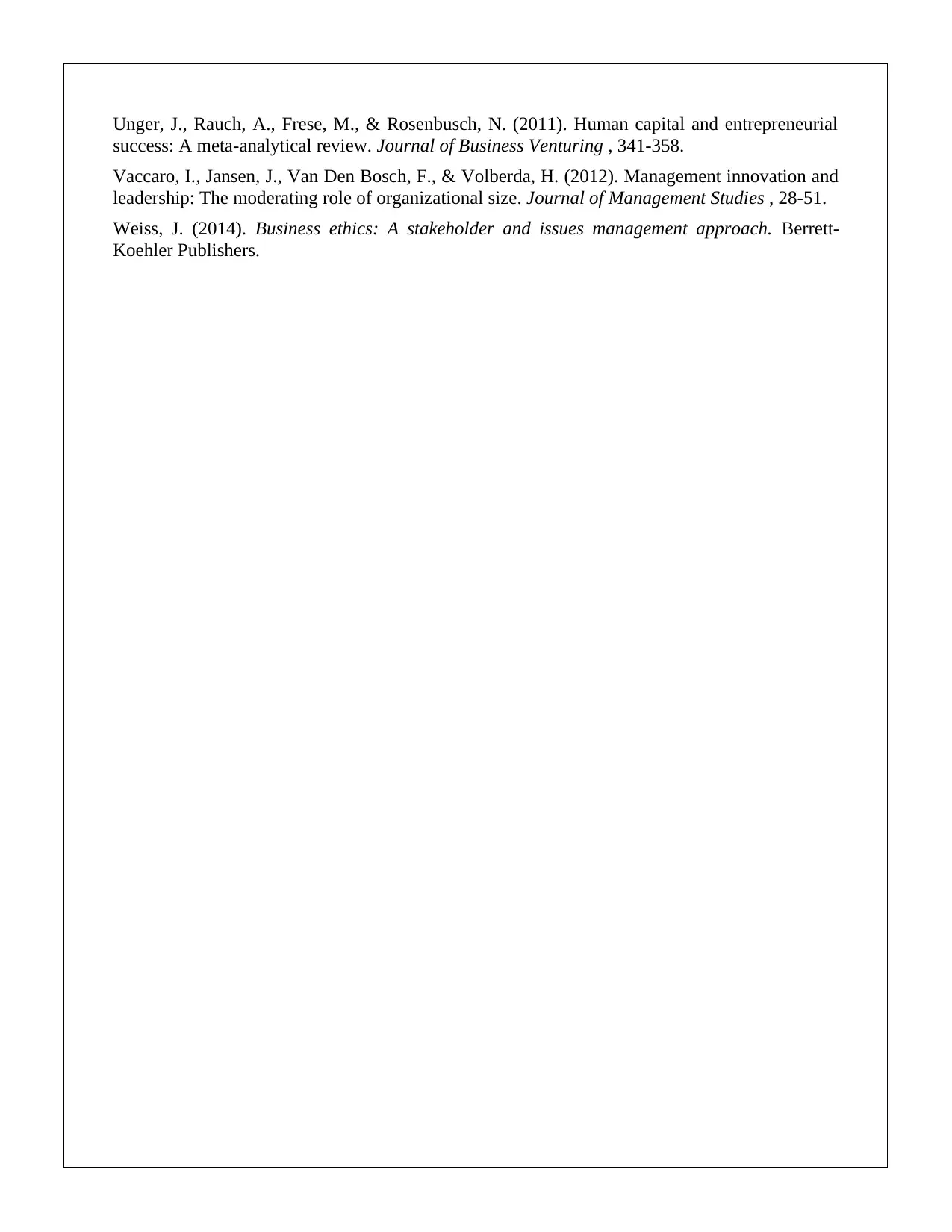
Unger, J., Rauch, A., Frese, M., & Rosenbusch, N. (2011). Human capital and entrepreneurial
success: A meta-analytical review. Journal of Business Venturing , 341-358.
Vaccaro, I., Jansen, J., Van Den Bosch, F., & Volberda, H. (2012). Management innovation and
leadership: The moderating role of organizational size. Journal of Management Studies , 28-51.
Weiss, J. (2014). Business ethics: A stakeholder and issues management approach. Berrett-
Koehler Publishers.
success: A meta-analytical review. Journal of Business Venturing , 341-358.
Vaccaro, I., Jansen, J., Van Den Bosch, F., & Volberda, H. (2012). Management innovation and
leadership: The moderating role of organizational size. Journal of Management Studies , 28-51.
Weiss, J. (2014). Business ethics: A stakeholder and issues management approach. Berrett-
Koehler Publishers.
1 out of 17
Related Documents
Your All-in-One AI-Powered Toolkit for Academic Success.
+13062052269
info@desklib.com
Available 24*7 on WhatsApp / Email
![[object Object]](/_next/static/media/star-bottom.7253800d.svg)
Unlock your academic potential
© 2024 | Zucol Services PVT LTD | All rights reserved.





